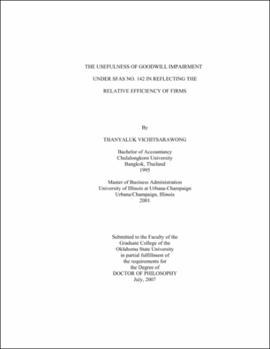| dc.contributor.advisor | Hansen, Don R. | |
| dc.contributor.author | Vichitsarawong, Thanyaluk | |
| dc.date.accessioned | 2013-11-26T08:31:17Z | |
| dc.date.available | 2013-11-26T08:31:17Z | |
| dc.date.issued | 2007-07 | |
| dc.identifier.uri | https://hdl.handle.net/11244/7146 | |
| dc.description.abstract | Scope and Method of Study: This study examines goodwill impairment under SFAS No. 142 whether it improves financial reporting quality by better reflecting the underlying relative efficiency of a firm. A firm's relative efficiency is measured by using Data Envelopment Analysis (DEA). The analysis is undertaken on three selected industries--durable manufacturers, computers, and services. First, Wilcoxon rank sum tests are used to compare the efficiency of a firm with other firms in the same industry (the cross-sectional analysis) and with similar firms over different periods (the longitudinal analysis). Second, Tobit and logistic regressions are applied to analyze factors affecting the percentage of goodwill impairment and a decision to report goodwill impairment. Finally, a logistic regression and a multivariate discriminant analysis (MDA) are used to assess the predictive ability of relative efficiency in determining potential goodwill impairment. | |
| dc.description.abstract | Findings and Conclusions: Results of Wilcoxon rank sum tests strongly support the hypothesis that impairment firms are relatively less efficient than non-impairment firms in the year of goodwill impairment reporting. Tobit and logistic regressions provide evidence that lagged relative efficiency of firms is negatively associated with the percentage of goodwill impairment and a decision to report goodwill impairment, after controlling for managerial reporting incentives. The inferences are robust to the choice of various input/output variables in the DEA model. The results suggest that the relative efficiency is an important determinant of goodwill impairment. Finally, results of logistic regressions used to assess the predictive ability of relative efficiency indicate that measures of relative efficiency can be used to identify the likelihood of goodwill impairment. The MDA models including relative efficiency measures correctly predict more than 50 percent of the actual impairment. These findings provide opportunity for future research to include a measure of firm overall performance in the prediction model. Overall, goodwill impairment under SFAS No. 142 can reflect the decline in relative efficiency of firms, thereby achieving the FASB's objective. | |
| dc.format | application/pdf | |
| dc.language | en_US | |
| dc.rights | Copyright is held by the author who has granted the Oklahoma State University Library the non-exclusive right to share this material in its institutional repository. Contact Digital Library Services at lib-dls@okstate.edu or 405-744-9161 for the permission policy on the use, reproduction or distribution of this material. | |
| dc.title | Usefulness of goodwill impairment under SFAS No. 142 in reflecting the relative efficiency of firms | |
| dc.contributor.committeeMember | Meek, Gary K. | |
| dc.contributor.committeeMember | Nabar, Sandeep | |
| dc.contributor.committeeMember | Tilley, Daniel S. | |
| osu.filename | Vichitsarawong_okstate_0664D_2417.pdf | |
| osu.accesstype | Open Access | |
| dc.type.genre | Dissertation | |
| dc.type.material | Text | |
| thesis.degree.discipline | Business Administration | |
| thesis.degree.grantor | Oklahoma State University | |
